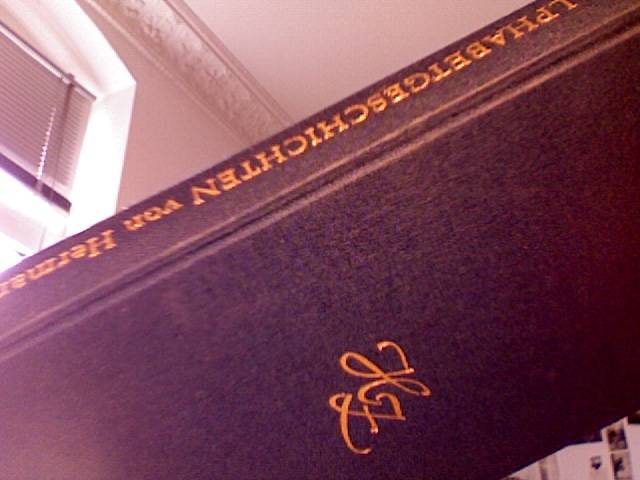Zapf¶
724 words on Books
This week was full of great things from my favourite TEX user group. Not only did they send a reminder to pay my membership fee - which isn’t too high although I think I could have easily paid for a copy of MS Word with the money I paid for it in the last 15 years or so. And it’s a great way to give a little money which is then used to support projects that improve TEX even more. But that wasn’t the main point, they also sent the members’ newsletter a DVD with all TEX-related files you could want along with a special treat.
A fantastic special treat in fact: The book Alphabetgeschichten by Hermann Zapf - who is an honourary member of DANTE - about his life, the history of his work and its technical development. It’s a very nice book set in current Palatino antiqua and sans serif faces and cloth bound as a hardcover which is still a bit flexible and has a very good feel to it. But apart from the outer appearances it also gives a list of the amazing amount of great typefaces Zapf made and a glimpse at the history surrounding them.
With numerous images of early works and his sketches it underlines the impression that Zapf leaves for his calligraphical and handwriting skills which you can still see in many of his typefaces. Even his early works already have what I think of as that typical Zapf taste. It’s also great to see how someone who learned things in the old school - drawing by head and making faces for lead print - is keen on keeping up to date with new developments like phototypesetting or the digital world of DTP and adapting his typefaces to embrace these new technologies, to drop off the limitations of the old and get the best result possible. I guess I’m a bit of a fan.
I have been a Zapf fan for a while. I’m sure that started with Zapf Chancery and Dingbats which came with my first Mac and which were just exciting back then - no matter how non-exciting they may seem today. I also grew fond of Palatino in that time but only learned it was Zapf’s a bit later on.
One of the coolest experiences I had with Palatino was when I got a used Mac for a friend before he started studying. He had absolutely no idea about computers and no interest either, but he knew he’d need one for writing essays while studying. So I put everything into place, including ‘Stationery Pads’ for writing essays and letters. Sometime in his first year he told me that he had been complimented for the good look of his essays. Which shocked him because he hadn’t even made an effort. The power of ClarisAppleWorks, reasonably pre-set margins and Palatino, I say. Makes you stand out among the Word using crowds.
And then I learned about Optima and despite my general scepticism about sans serifs I grew to like it for its organic looks. Later, with MacOS X.2, I got my hands on Zapfino. Which is a difficult beast and one that is probably overused these days but which remains drop-dead gorgeous and leaves me salivating every now and again.
To drive home the point, this page is set in all-Zapf typefaces (if you are using a Mac or otherwise sufficiently equipped computer): Optima for the headings and sidebars, Zapfino for post names and Palatino for the main text. Hope you enjoy it. (Usually I am using Georgia for the main text because I find Palatino a bit too thin on-screen at small sizes.)
It’s not entirely clear to me to which extent this book will be available. It read like the German edition isn’t publicly available but an English edition named Alphabet Stories · A Chronicle of Technical Developments by Hermann Zapf will be published, though at a limited 300 copy run which could make it hard to get. I couldn’t find the book listed in any catalogues at this stage, though. In case you are interested here are a few search links: Worldcat, Google for alphabet stories, Google for Alphabetgeschichten, .

